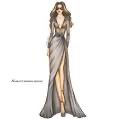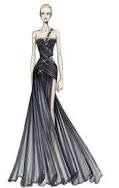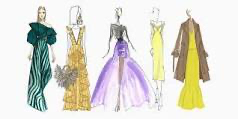Fashion design is an applied art specialized in designing clothes, and it is part of human behavior. A person usually seeks to satisfy his needs, and for this he uses his imagination, knowledge and skill in creating what achieves these needs. Design is a temporal or seasonal art, as it is affected by what is around it and is considered one of the consequences of cultural life and social influences. This art is characterized by renewal, diversity, and dazzling season after season.
Fashion design may be defined as that innovative and renewed entity in its lines, color spaces, and various materials, with which the fashion designer tries to translate the elements of formation into an innovative design that copes with the conditions of reality in a beautiful plastic way. It is an additional process, the purpose of which is to create a new work that performs several functions, including material and aesthetic, meaning that the design process is an innovative work that achieves its purpose by adding something new.
And the designers of the world agreed that there would be two seasons of fashion annually, a specific season for fall and winter or spring and summer. Among the most famous cities interested in fashion are Paris, Milan, London and New York, and there are the most famous designers in these cities, historically and at the present time. Like Coco Chanel, the owner of the House of Chanel. And Yves Saint Laurent, Christian Dior, and new ones Calvin Klein and Ralph Lauren.
Fashion design is the language formed by a group of elements in a unified composition (line, shape, color, and texture), and these variables are the basis for its expression, and are affected by the design foundations to give control, integration, balance, rhythm, and proportion, so that the individual finally gets a costume that makes him feel consistent and connects him to the society in which he lives. Fashion design is subject to flexible elements that are easy to exchange and form, such as materials, which are fabrics and textiles, whether woven or non-woven, and at the present time they have become multi-types, colors, and textile composition, and there are now many raw materials produced from synthetic fibers in addition to natural and blended fibers that have a special nature.
The design is a planning process, where the designer works to find a solution to the problem based on the client’s requirements, information and capabilities available to him, and he must rely on experimental methods to ensure that the design takes into account all the requirements and conditions imposed.
The world of fabrics greatly affects the world of fashion, and we can say that the textile industry is the first engine to lay the foundation for fashion every year, of course, in consultation with the world’s leading designers. This art in general began in the nineteenth century with Charles Frederick, who was the first person to put a mark on his products. Only clothes created after 1858 can be considered couture.
The world of fashion is divided into two types of clothing: high-end clothing and ready-made clothing. We may find a designer who does both, especially international designers with very high capital. The clothing industry is a big business and a very strong resource in some countries, and famous designers are among the richest people in the world.
The fields and methods of fashion design vary according to the target market, and fashion can be divided into four main types:
Show costumes: Costume Design
The term show costume design is used to express the costumes used in theatrical and cinema performances, and the show costume designer often designs shoes, hats, head clothes, and sometimes also designs the masks and makeup that the actor will appear with.
Couture: Haute Couture
Fashion design before 1950 AD was limited to haute couture or fashion designed for a made-to-measure (fashion designed for a specific client), and haute couture design is used to define fashion designed for a well-defined category of consumers, and the fashion of this category is characterized by elegance And the high quality and the use of high-priced materials and woven with great care in all details and final finishes.
Ready-to-Wear
Ready-to-wear is clothing that combines some of the qualities of haute couture and mass production clothing. It is not designed for a specific customer, but it is characterized by great care in selecting its raw materials and stages of cutting and production
Quantitative Production: Mass Market
We find that the clothing industry these days relies heavily on quantitative production, and these clothes are produced in large quantities, with fixed and specific sizes, and with relatively cheap materials, and designers of quantitative production clothing use fashion trends set by fashion designers in high-end fashion houses and ready-made clothes.
It is agreed that design has two meanings, as it is a process (verb) and a product (noun), as a process: searching and identifying the source of inspiration, planning and organizing to achieve the design goals, and as a noun: it is the final product of this process.
Functional design:
It is primarily related to the function of the design and the purpose for which it was designed, i.e. the functional aspect of the garment. When developing the idea, the designer puts in mind the function of the thing to be designed. Designing evening costumes differs from designing costumes for attending a masquerade party.
Structural design:
In the field of clothing design, the structural design of the process of building and planning the garment consists of defining its external structural lines and the details of its internal parts to serve the human body and its comfort by using fabric in its formation, as it takes into account the quality of the material that is used in implementation. It may be woven or non-woven and knitted, as it plays an important role in its durability and quality. In order to preserve the building of the model and its external structure, and thus its aesthetic appearance.
It is the design that is determined through several questions that lie in how to build and define the lines and shapes of the parts to be designed, and how to combine its structural design and function and their connection with each other in giving the simplified shape that leads to the purpose for which it was designed.
decorative design:
It is a development of structural design for the purpose of adding aesthetics that change the external structure or its character. It is done in designing clothes in one of two ways, either by adding external materials to the piece of clothing such as threads and buttons without buttonholes, zippers, lace ribbons, bracelets, collars, and flip-flops without pockets, or by dyeing, printing, or embroidery units with its various styles of stitches Different so that these decorations agree with the building design, making it appear more elegant and beautiful to attract attention to it. The decorative design, despite its simplicity, is sometimes indispensable for the design, even to give it more richness.
Dividing the design into functional, structural and decorative design does not mean that each of them is an independent part or that each of them is not related to the other, but the functional design must be inclusive of the structural design and the structural design inclusive of the decorative design and at the same time complementary and expressive of the functional design and that the decorative design is complementary to the design Constructive and so on so that each of them serves the other and highlights it.



